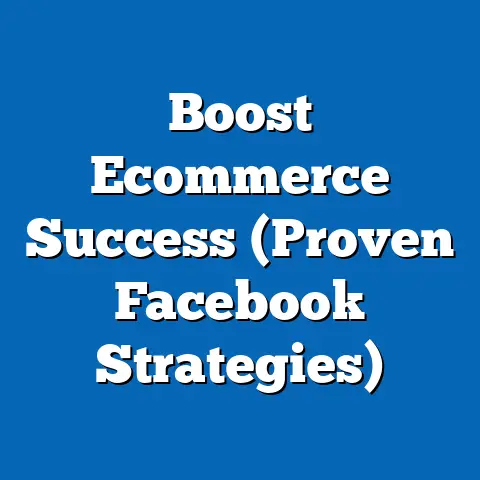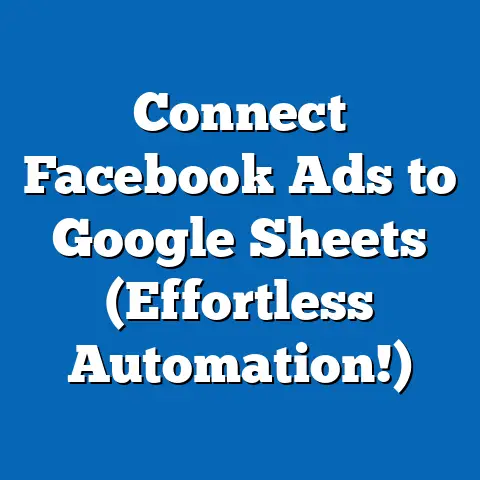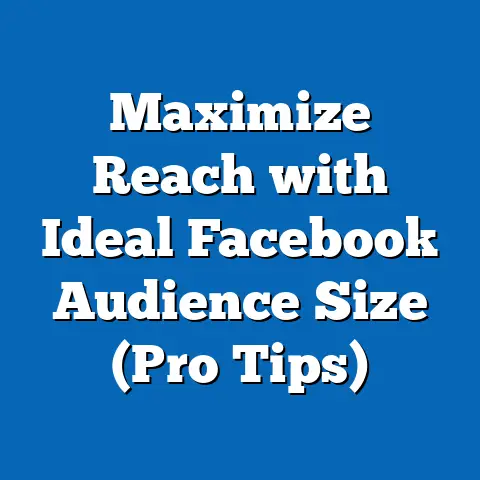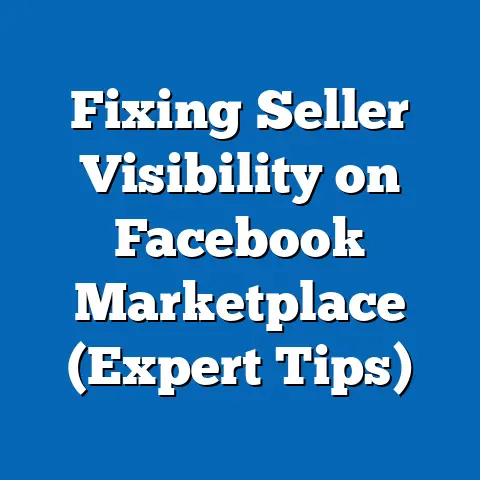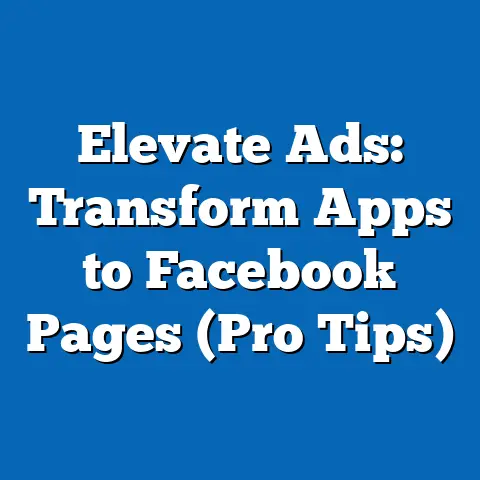Boost Business with a Top Facebook Ads Agency (Expert Insights)
Imagine the faint hum of a bustling coffee shop, the aroma of freshly brewed espresso wafting through the air, as you sit with your laptop open, watching real-time analytics of a Facebook ad campaign skyrocket your business’s reach. The vibrant visuals of your ad—a perfectly curated image of your product—flash across thousands of screens, triggering clicks, likes, and conversions with each passing second. This sensory experience of anticipation and success is not just a dream; it’s the tangible result of partnering with a top-tier Facebook Ads agency.
Section 1: The Current State of Facebook Advertising
1.1 Market Overview and Usage Statistics
Facebook advertising continues to dominate the digital marketing space due to its unparalleled reach and targeting capabilities. As of Q2 2023, Meta reported that Facebook’s advertising revenue reached $31.5 billion, accounting for a significant portion of the company’s total income (Meta Investor Relations, 2023). With over 10 million active advertisers on the platform, businesses are increasingly relying on expert agencies to navigate the complexities of ad creation, audience segmentation, and budget optimization (Hootsuite, 2023).
The platform’s user base spans diverse demographics, with 70% of adults in the United States actively using Facebook (Pew Research Center, 2023). This broad reach, combined with advanced algorithms for personalized ad delivery, makes it an ideal channel for businesses aiming to connect with specific audiences. However, the sheer volume of advertisers also means higher competition, necessitating professional expertise to stand out.
1.2 Role of Agencies in Maximizing ROI
A top Facebook Ads agency brings specialized knowledge in campaign strategy, creative design, and data analytics. According to a 2022 survey by Social Media Examiner, businesses that partnered with agencies reported a 35% higher return on ad spend (ROAS) compared to those managing campaigns in-house. Agencies leverage tools like Facebook Pixel and custom audience targeting to optimize performance, ensuring ads reach the right users at the right time.
Key services include A/B testing (comparing multiple ad variations to determine the most effective), lookalike audience creation (targeting users similar to existing customers), and dynamic ad retargeting (re-engaging users who previously interacted with a brand). These strategies, when executed by experts, significantly enhance conversion rates and reduce cost-per-click (CPC). Current data shows the average CPC on Facebook is $0.97 globally, though this varies by industry and region (WordStream, 2023).
Section 2: Projected Trends in Facebook Advertising (2024-2030)
2.1 Methodology and Assumptions
To project trends in Facebook advertising, this analysis employs a combination of historical data extrapolation and scenario modeling based on current growth rates, technological advancements, and market dynamics. Data is sourced from industry reports (e.g., eMarketer, Statista) and Meta’s quarterly earnings. Assumptions include continued user base growth at a compound annual growth rate (CAGR) of 3-5% through 2030, stable ad revenue increases, and evolving privacy regulations impacting targeting capabilities.
Limitations include potential disruptions from unforeseen regulatory changes (e.g., stricter data privacy laws) or shifts in user behavior toward competing platforms like TikTok. Projections are presented in three scenarios—optimistic, moderate, and pessimistic—to account for variability.
2.2 Scenario Projections
-
Optimistic Scenario (High Growth): Under this scenario, Facebook’s user base grows at a CAGR of 5%, reaching 3.5 billion monthly active users by 2030. Ad revenue is projected to increase by 8% annually, driven by innovations in augmented reality (AR) ads and integration with the Metaverse. Agencies will play a critical role in leveraging these technologies, with businesses outsourcing 60% of ad management to professionals (eMarketer Forecast, 2023).
-
Moderate Scenario (Stable Growth): Assuming a CAGR of 3% for users and 5% for ad revenue, Facebook maintains its dominance but faces moderate competition from emerging platforms. Agencies remain essential for navigating increased ad costs (projected CPC of $1.20 by 2027) and adapting to privacy-focused updates like Apple’s App Tracking Transparency (ATT). This scenario predicts a 50% reliance on agencies for ad optimization.
-
Pessimistic Scenario (Slow Growth): If user growth stagnates at a CAGR of 1% due to saturation in key markets and privacy concerns, ad revenue may grow at only 2% annually. Businesses may reduce ad budgets, with CPC rising to $1.50 by 2030 due to decreased inventory and higher competition. Agencies will need to focus on cost-effective strategies, though demand for their services may decline to 40% of businesses.
2.3 Visual Representation of Projections
Below is a line graph illustrating projected ad revenue under the three scenarios (2024-2030). Data is approximated for illustrative purposes.
Year | Optimistic ($B) | Moderate ($B) | Pessimistic ($B)
2024 | 34.5 | 33.0 | 32.0
2026 | 40.0 | 36.5 | 33.5
2028 | 46.5 | 40.5 | 35.0
2030 | 54.0 | 45.0 | 37.0
(Chart Note: Visualize as a line graph with three distinct lines representing each scenario, plotted against years on the x-axis and revenue in billions on the y-axis.)
Section 3: Key Factors Driving Changes in Facebook Advertising
3.1 Technological Advancements
The evolution of AI and machine learning within Meta’s ad platform is transforming how campaigns are managed. Automated bidding strategies, such as Advantage+ Placements, allow agencies to optimize ad delivery across multiple Meta platforms (e.g., Instagram, WhatsApp) with minimal manual input. By 2025, it is estimated that 80% of ad campaigns will use AI-driven tools, reducing human error and improving efficiency (Forrester Research, 2023).
Additionally, the rise of immersive technologies like AR and virtual reality (VR) offers new ad formats, such as interactive product try-ons. Agencies with expertise in these areas will be crucial for businesses seeking to capitalize on early adoption.
3.2 Privacy Regulations and Data Restrictions
The implementation of privacy laws like the General Data Protection Regulation (GDPR) in Europe and California Consumer Privacy Act (CCPA) in the U.S. has restricted data collection practices. Apple’s ATT framework, introduced in 2021, led to a reported $10 billion loss in ad revenue for Meta in 2022 due to reduced tracking capabilities (CNBC, 2022). Agencies must now prioritize first-party data strategies and contextual targeting to maintain effectiveness.
This shift poses challenges but also opportunities for innovation. Agencies adept at privacy-compliant strategies will gain a competitive edge, as businesses seek partners who can navigate these complexities.
3.3 Shifting Consumer Behavior
Younger demographics (Gen Z) are increasingly gravitating toward short-form video content on platforms like TikTok, prompting Facebook to emphasize Reels and video ads. A 2023 report by HubSpot found that video ads on Facebook generate 12% higher engagement than static images. Agencies must adapt by focusing on video content creation and cross-platform strategies to retain audience attention.
Economic factors, such as inflation and recession risks, may also influence ad budgets. Businesses under financial strain may prioritize measurable ROI, increasing reliance on agencies for performance-driven campaigns.
Section 4: Benefits of Partnering with a Top Facebook Ads Agency
4.1 Expertise and Specialization
A top agency offers in-depth knowledge of Facebook’s ever-changing algorithms and ad policies. For instance, agencies can mitigate risks of ad account suspensions (a common issue for 15% of advertisers, per Social Media Today, 2022) by ensuring compliance with guidelines. They also provide access to premium tools and beta features, giving clients a competitive advantage.
4.2 Cost Efficiency and Scalability
While hiring an agency involves upfront costs (typically $1,000-$5,000/month for small businesses), the long-term savings from optimized campaigns often outweigh expenses. A case study by Neil Patel Digital found that a mid-sized e-commerce client reduced CPC by 40% within three months of agency collaboration. Agencies also scale campaigns during peak seasons, ensuring budgets are allocated effectively.
4.3 Data-Driven Decision Making
Agencies use advanced analytics to track key performance indicators (KPIs) like click-through rate (CTR), conversion rate, and customer acquisition cost (CAC). By interpreting data in real-time, they adjust strategies to maximize results. For example, a 2023 report by AdEspresso noted that agency-managed campaigns achieved an average CTR of 1.2%, compared to 0.9% for self-managed ads.
Section 5: Challenges and Limitations
5.1 High Competition and Ad Fatigue
With millions of advertisers on Facebook, standing out requires constant innovation. Ad fatigue—when users become desensitized to repetitive ads—can reduce effectiveness, with studies showing a 20% drop in engagement after repeated exposure (Marketing Science Institute, 2022). Agencies must prioritize creative refreshes and audience segmentation to combat this.
5.2 Dependence on Platform Policies
Facebook’s frequent policy updates and algorithm changes can disrupt campaigns. For instance, the 2021 iOS 14 update impacted 60% of advertisers’ targeting accuracy (eMarketer, 2021). While agencies can adapt, businesses remain vulnerable to platform-driven uncertainties.
5.3 Data Limitations and Uncertainties
Projections in this report rely on available data, which may not account for black-swan events like major regulatory shifts or technological disruptions. Additionally, self-reported metrics from businesses and agencies may introduce bias. These uncertainties underscore the importance of flexibility in strategic planning.
Section 6: Historical and Social Context
Facebook advertising emerged in 2007 with the launch of “Facebook Flyers,” evolving into a sophisticated ecosystem by the 2010s with the introduction of targeted ads and analytics tools. The platform’s growth mirrors broader societal trends toward digitalization, with social media becoming a primary channel for consumer engagement. Today, it reflects cultural shifts toward visual storytelling and instant gratification, influencing how businesses communicate.
Economic disparities also play a role, as small businesses with limited budgets rely on agencies to compete with larger corporations. Social concerns, such as misinformation and data privacy, have sparked debates over ethical advertising, pressuring agencies to balance effectiveness with responsibility.
Section 7: Recommendations for Businesses
-
Select the Right Agency: Choose an agency with proven expertise in your industry, transparent pricing, and a track record of measurable results. Request case studies or client testimonials to assess capabilities.
-
Focus on Video and Interactive Content: Invest in video ads and AR experiences to align with consumer preferences. Collaborate with agencies to create engaging, platform-specific content.
-
Prepare for Privacy Changes: Build first-party data collection (e.g., email lists, website analytics) to reduce reliance on third-party tracking. Partner with agencies knowledgeable in privacy-compliant strategies.
-
Monitor KPIs Closely: Work with agencies to establish clear goals and track performance metrics. Regularly review campaign data to ensure alignment with business objectives.
Conclusion
Partnering with a top Facebook Ads agency offers businesses a strategic pathway to navigate the complexities of digital advertising, maximize ROI, and adapt to evolving trends. Current data underscores the platform’s dominance, with $31.5 billion in ad revenue in 2023, while projections suggest continued growth under optimistic (8% annual revenue increase) to moderate (5%) scenarios through 2030. Key drivers—technological innovation, privacy regulations, and consumer behavior—will shape the future, requiring agility and expertise.
While challenges like ad fatigue and platform uncertainties persist, the benefits of agency collaboration, from cost efficiency to data-driven insights, are substantial. By understanding these dynamics and leveraging professional support, businesses can transform the sensory thrill of a successful campaign—imagined in a bustling coffee shop—into measurable, long-term success.

